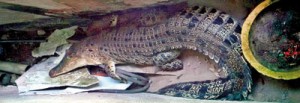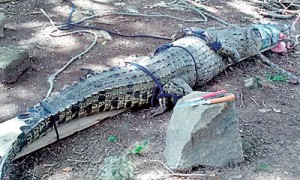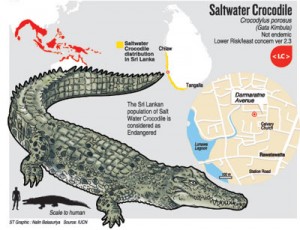News
The saltie that terrorised Rawatawatte
A resident of Dharmaratne Avenue in Rawatawatte, Moratuwa, was returning home after his night shift around 2 a.m. when his van’s headlights picked out something that looked like a slowly moving log.
Disturbed by the sound of the vehicle the “log” came to life, lunging to the side of the road and entering a neighbour’s garden. The resident got home and told his father, D. Perera, who telephoned and alerted the neighbour to the presence of the trespasser.

Guess who came to the garden? A 7.2-foot saltwater crocodile
The police were called on 911 and with the Pereras and their neighbours began a search with torches. Soon the trespasser was found, lost and equally or more terrified than the search party – a 7.2-foot saltwater crocodile.
The police and residents managed to corner the croc near a wall and called the Department of Wildlife Conservation. One person also alerted a croc expert, Avishka Godahewa, who lives close by. Mr. Godahewa, a member of the International Union for the Conservation of Nature (IUCN) Crocodile Specialist Group, is permitted by the Department of Wildlife Conservation to handle wild crocs.
With the department’s approval, he rushed to Rawatawatte to take care of the intruder. Although a fearsome predator, the Rawatawatte croc was a frightened beast in unfamiliar, hostile territory.

Capturing the crocodile was not an easy task
After checking out the croc, Mr. Godahewa decided how it should be captured and carried out the rescue mission with the assistance of his father.
The croc was not tired and had plenty of fight left in it, so capturing it was not an easy task as the onlookers’ safety had also to be considered; the whole neighbourhood had by now gathered to see the croc.
Mr. Godahewa tied up the crocodile and took it quickly to a safe croc habitat. As soon it was released the croc rushed to the water in relief at returning to familiar territory.
Sri Lanka is home to two species of crocodile: the saltwater crocodile (Crocodylus porosus) or geta kimbula in Sinhala, is larger than its cousin, the mugger crocodile (Crocodylus palustris) or hala kimbula.
The Sri Lankan population of saltwater crocodiles is considered endangered and some of the wetlands such as the Weras Ganga and the Lunawa lagoon in Colombo are the last hideouts of this species in the Colombo suburbs. Hence, even though it is a feared creature, it is important to protect the remaining individuals.
| ‘Gaddafi’ catcher was here to train local croc huntersSteve Irwin’s famous Crocodile Hunter episodes shown on television made catching a croc look easy but it is an extremely dangerous job: a simple mistake could cost the hunter a limb or his life. To help Department of Wildlife Conservation officers learn how to catch and rescue trapped or straying crocodiles training seminars were held recently led by internationally-acclaimed crocodile hunter, Peter Prodromou. Mr. Prodomou has worked in Uganda with Nile crocodiles. He became famous for catching a killer croc called Gaddafi that accounted for three lives in Uganda. Before catching this croc, Peter used methods such as placing a dummy of a human child to check which croc attacked first in order to single out the culprit responsible for the attacks. In Sri Lanka, soon after an attack, people hurriedly put out bait to catch a crocodile that comes close to the area. While this might snare the real culprit as crocs are usually territorial, there is a higher chance that one that is not responsible for the attack gets caught. During the training, Mr. Prodomou showed the wildlife officers easier techniques such as using floating baits to catch a nuisance croc. The training was organised for the DWC by Avishka Godahewa, together with his brother, Avinda, and a colleague, Mafas Mohammed, both of whom are also members of the Crocodile Specialist Group. |
“I was woken by the SOS call from a panicked neighbor,” he said of that day, August 29. “I don’t call them nuisance croc calls but croc rescue calls as otherwise terrified people continue harassing the crocs, even killing them,” he said.Twenty-year-old Avishka Godahewa, the youngest member of the IUCN’s Crocodile Specialist Group, has so far rescued about 10 crocodiles from the Rawatawatte area.
Dharmaratne Avenue is a highly residential area and the nearest water source is about 300-400 metres away. The crocodiles have a habit of leaving their waterholes at night to go in search of food or other waterholes, Dr. Anslem de Silva, the country’s foremost expert on the reptiles, said.
Three more crocs were rescued in Ambalantota in the Hambanthota District in the past few weeks. One had trespassed into a home garden close to its waterway while the other two had become entangled in fishing nets laid in a small village tank, the Nonagama Wewa. All three were mugger crocodiles. Wildlife officers caught them safely and released them to the Udawalawe tank.


